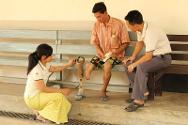Myanmar: On International Mine Awareness Day, repairing what others have sown
03-04-2014 Feature
Since the Second World War, Myanmar has witnessed an accumulation of landmines and unexploded ordnance that has affected untold numbers of people. The legacy of these weapons, worldwide and across Myanmar, claims thousands of new victims each year. ‘International Mine Awareness Day’ draws attention to the issue and highlights progress towards their eradication.

Hpa-an Orthopaedic and Rehabilitation Centre, Myanmar.
Edison lost his leg when he was just 24 years old. As a soldier in the army, he and two friends were sent to collect bamboo for construction work. As they walked into the forest, Edison's foot triggered a landmine explosion. He comes to the Hpa-an rehabilitation centre every year to have his prosthesis repaired and renewed.
© ICRC / Jan Powell
Physically rehabilitating the survivors – civilians and military personnel alike – of landmines, other weapons, accidents and other causes is an enormous task. The arithmetic is formidable: the World Health Organization estimates that 0.5% of the population (one person in every 200) is physically disabled. In a population of 60 million that means 300,000 people across many parts of Myanmar are likely to be in need of physical rehabilitation services.
In 2013, ICRC-supported physical rehabilitation programmes in Myanmar provided more than 1,700 prostheses to disabled people, of whom some 760 were survivors of landmines. In Mandalay region, the physical rehabilitation centre in the Ministry of Health’s Yenanthar Leprosy Hospital provided nearly 200 prostheses, of which just 38 went to landmine survivors. But in Hpa-an, where the Myanmar Red Cross Society has run a physical rehabilitation centre since 2003, 63% of the 1,030 people provided with a prosthesis were landmine survivors. The impact of being close to areas where fighting has occurred is obvious.
A daunting task
“MRCS medical staff in branches around Myanmar referred 695 disabled people to the Hpa-an and Yenanthar centres, so that they could access physical rehabilitation services,” explains Didier Reck, the ICRC’s Myanmar physical rehabilitation programme manager. “The ICRC supports people in need of services by paying their travel, accommodation and living expenses during the average three weeks they need to spend at a physical rehabilitation centre having a prosthesis fitted, and this includes assisting a parent to be present if the victim is a child,” he adds.
To sustain these services is a daunting task. The lifespan of a prosthetic limb is, on average, just three years. To assist the estimated number of physically disabled people in Myanmar would require 400 trained ortho-prosthetists. There are currently just ten in the country.
Ortho-prosthetists can be trained at universities abroad in three years. Universities in Myanmar will introduce a four-year ortho-prosthetist training course in 2015, with the first year being common to a range of medical professionals, including physiotherapists, laboratory technicians, radiologists and ortho-prosthetists.
Leo Gasser, the ICRC’s orthotics and prosthetics specialist in Myanmar, is a strong advocate for training more local professionals in his field. “To improve access to assistance for the many landmine survivors in the north and the east of Myanmar, the ICRC is in the early stages of establishing physical rehabilitation centres in Myitkyina and Khaing Tong,” he explains, adding, “but we can only meet the demand for services if we can also address the shortfall in ortho-prosthetic specialists as quickly as possible.”
Improving the chances of success

Hpa-an Orthopaedic and Rehabilitation Centre, Myanmar.
Technicians check Edison's stump for pressure points after a session practising with his new leg. After his accident, Edison had to leave the army. Being able to walk without crutches means that he can work as a teacher in his home town.
© ICRC / Jan Powell
Not every mine survivor can easily wear a prosthesis but good surgical techniques can help improve the prospects. Once a year, surgeons in Myanmar have the opportunity to attend a seminar on amputation, held in Yangon, giving mine survivors the best possible chance of being able to wear a prosthesis once they recover from the trauma. The seminars are run by the Myanmar Medical Association and the national Red Cross, with the support of the ICRC.
For over 20 years, working in close partnership with the Myanmar Red Cross and the Ministry of Health, the ICRC has given technical and financial support to physical rehabilitation programmes in Myanmar – an activity it intends to continue. Physical rehabilitation is often the first step for landmine survivors and other persons with physical disabilities to having the same opportunities as others in society. Farming, or finding a job, for example, can be very difficult unless mobility is restored.
The International Day for Mine Awareness & Assistance in Mine Action, observed on 4 April each year, helps to raise awareness about landmines and the efforts being made towards their eradication.